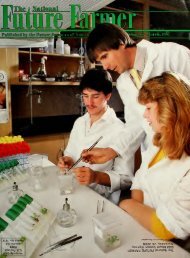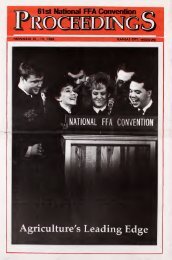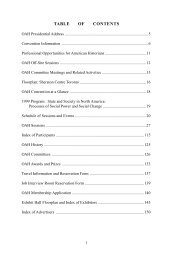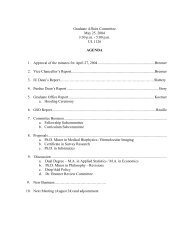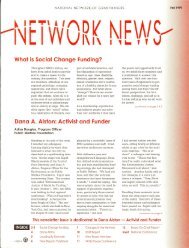Proceedings, 1997
Proceedings, 1997
Proceedings, 1997
Create successful ePaper yourself
Turn your PDF publications into a flip-book with our unique Google optimized e-Paper software.
National Extemporaneous<br />
Public Speaking<br />
Sponsored by American Farm Bureau Federation<br />
Extemporaneous public speakers are not only faced with the challenge of giving<br />
top-notch presentations, they have to do it with only 30 minutes of preparation. The<br />
national winner received a $300 award, second place earned $275, third place $250 and<br />
fourth place $225.<br />
National Winner Second Place<br />
Chris Welti<br />
Plant City FFA Chapter<br />
Plant City, Fla.<br />
Solving the Problem of<br />
Bacteria Contamination in<br />
Food<br />
Chris Vitclli, Plant City Fla.,<br />
FFA Chapter-<br />
Many of you may be familiar<br />
with the late successful retailer Mr.<br />
Sam Walton of WalMart fame. But in<br />
the late 1950s Mr. Walton was a<br />
struggling businessman about to open<br />
his second five n' dime store in<br />
country town of Arkansas. Mr.<br />
Walton needed to attract lots of<br />
people for his grand opening, so he<br />
decided to give away watermelons<br />
and free donkey rides out front for the<br />
kids. As it started getting hot and<br />
humid they swung the front doors of<br />
the store open wide. Much to their<br />
surprise it began to pour down rain.<br />
Once the lightning began the donkeys<br />
got spooked and began running<br />
around outside the front of the store.<br />
During the process, the donkeys<br />
stepped on the watermelons, crushing<br />
them into mush. The mush<br />
eventually mixed with the watermel-<br />
ons and the donkey manure, creating<br />
an incredible mess. As the heavy rain<br />
continued, this conglomeration<br />
spilled through the front doors onto<br />
the floor. Needless to say, it wasn't a<br />
pleasant sight for Mr. Walton and his<br />
second grand opening.<br />
But do you know this scenario<br />
certainly wouldn't have pleased the<br />
food safety sector or the agricultural<br />
industry even in the late 1950s.<br />
Today we will focus on food safety<br />
concerns and how we can combat the<br />
vith contamination of our<br />
Paul Lewis<br />
Groton FFA Chapter<br />
Groton, S.D.<br />
foods. We will start by identifying the<br />
food safety issues of today. Secondly,<br />
we will focus on technological<br />
advancements which play a key role<br />
in combating the problem of food<br />
safety. And last but not least, we will<br />
focus on the governments role of food<br />
safety in this country. But we'll start<br />
with my first point of analysis, the<br />
food safety issues.<br />
Infectious disease and outbreak<br />
investigations bring both excitement<br />
and frustration. It's exciting to know<br />
that the USDA is cracking down on<br />
those who violate the meat and<br />
poultry laws. But in retrospect, it's<br />
also very frustrating to hear about<br />
food safety problems every day.<br />
Recently, American consumers<br />
witnessed what the USDA calls the<br />
largest recall in beef history.<br />
A local newspaper in my<br />
hometown, The Parade, reported that<br />
Hudson Foods of Columbus, Neb.,<br />
recalled 25 million pounds of beef.<br />
The beef was recalled because of 17<br />
cases of E. coli 0157:H7 were<br />
detected in hamburger patties in<br />
Colorado, and were traced back to<br />
Hudson Foods, Inc. This case,<br />
followed by a recent case with Beef<br />
America Plant which recalled 170,000<br />
pounds of contaminated beef, has<br />
American consumers very apprehen-<br />
sive of the future of food safety in this<br />
country. We the American consumers<br />
can control contaminants within our<br />
homes by keeping a clean cooking<br />
environment and cooking our food at<br />
correct internal temperatures. We<br />
must continually rely on the<br />
government and the agricultural<br />
industry to explore technological<br />
15<br />
Third Place<br />
Josh Tewalt<br />
Meridian FFA Chaptei<br />
Meridian, Idaho<br />
advancements for the future of food<br />
safety. As you will see in my second<br />
point of analysis, technology plays a<br />
key role in combating the food safety<br />
problem with food contamination.<br />
On September 1, <strong>1997</strong>,<br />
Newsweek magazine reported that<br />
food irradiation is one approach to<br />
eliminating disease-causing bacteria.<br />
In relative terms, food irradiation<br />
involves exposing food to certain<br />
amounts of ionizing radiation to<br />
control contaminants such as E. coli,<br />
salmonella or Hepatitis A. It's<br />
important to realize that irradiated<br />
food is not radioactive. And<br />
according to the FDA, it does not<br />
constitute a health risk. By law all<br />
the irradiated food must be labeled<br />
as such. Some consumers may be<br />
very apprehensive of the future of<br />
this technological advancement. But<br />
in retrospect, it took 50 years for the<br />
pasteurization of milk to gain<br />
acceptance.<br />
You see, technology plays a key<br />
role in solving some of the food<br />
safety problems. But until the<br />
American consumers can identify<br />
and accept technological advancements<br />
such as food irradiation, we<br />
must allow the government to<br />
intervene and make strict regula-<br />
tions. As you will see in my third<br />
point of analysis, the government<br />
plays a key role in the future of food<br />
safety problems as well.<br />
A recent Newsweek poll stated<br />
that 51 percent of Americans are<br />
taking greater precautions with<br />
home-cooked food. An additional<br />
poll stated that 62 percent of<br />
Fourth Place<br />
Katy Poth<br />
Liberty Union FFA Chapter<br />
Pickerington, Ohio<br />
Americans want the government to<br />
take strict regulations on the future<br />
of food safety problems. The<br />
government must comply, and meet<br />
the food safety problem in our<br />
American society. One way of<br />
reaching this goal is outlined in the<br />
Washington Newswve on August 19,<br />
<strong>1997</strong>, which states that the<br />
government will implement the<br />
Hazard Analysis Critical Control<br />
Point system (HACCP). HACCP<br />
identifies key control points in food<br />
processing plants to eliminate<br />
contaminants. In addition, as of<br />
right now the USDA has no authority<br />
to mandate the recalls or stop the<br />
distribution of those who violate the<br />
meat and poultry laws. However, on<br />
August 29, <strong>1997</strong>, a USDA publica-<br />
tion stated that U.S. Secretary of<br />
Agriculture Dan Glickman proposed<br />
his law entitled the Food Safety<br />
Enforcement Enhancement Act of<br />
<strong>1997</strong>, which would give him the<br />
authority to take government action<br />
on those who violate these laws. The<br />
government plays a key role in the<br />
future of our food safety.<br />
In conclusion, Sam Walton<br />
learned a great lesson. He learned<br />
that food safety is essential to anyone's<br />
future in the industry of agriculture.<br />
And the agricultural industry is<br />
learning that food safety is very<br />
important for the future of their<br />
industry. The American consumers<br />
must continually become educated<br />
about technological advancements.<br />
At the same time, we have to rely on<br />
the government for the future of our<br />
food safety concerns.





